
List of images in Gray's Anatomy: II. Osteology
Encyclopedia
IntroductionIntroduction (essay)An introduction is a beginning section which states the purpose and goals of the following writing. The introduction is usually interesting and it intrigues the reader and causes him or her to want to read on. The sentence in which the introduction begins can be a question or just a statement...
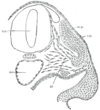



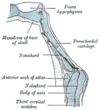

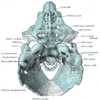

boneBoneBones are rigid organs that constitute part of the endoskeleton of vertebrates. They support, and protect the various organs of the body, produce red and white blood cells and store minerals. Bone tissue is a type of dense connective tissue...


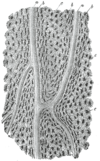





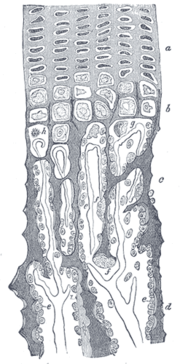
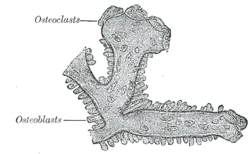
general characteristics of a vertebra


the cervical vertebraeCervical vertebraeIn vertebrates, cervical vertebrae are those vertebrae immediately inferior to the skull.Thoracic vertebrae in all mammalian species are defined as those vertebrae that also carry a pair of ribs, and lie caudal to the cervical vertebrae. Further caudally follow the lumbar vertebrae, which also...
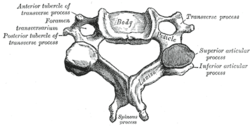
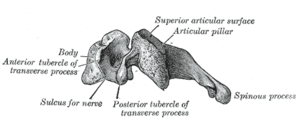

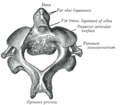


the thoracic vertebraeThoracic vertebraeIn human anatomy, twelve thoracic vertebrae compose the middle segment of the vertebral column, between the cervical vertebrae and the lumbar vertebrae. They are intermediate in size between those of the cervical and lumbar regions; they increase in size as one proceeds down the spine, the upper...
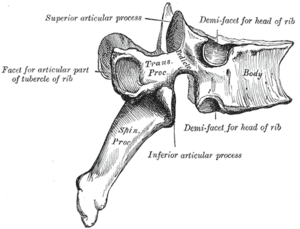


the lumbar vertebraeLumbar vertebraeThe lumbar vertebrae are the largest segments of the movable part of the vertebral column, and are characterized by the absence of the foramen transversarium within the transverse process, and by the absence of facets on the sides of the body...

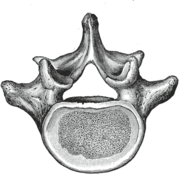
the sacralSacralSacral may refer to:*sacred*sacrum...
and coccygeal vertebrae




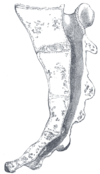




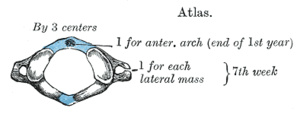






the vertebral columnVertebral columnIn human anatomy, the vertebral column is a column usually consisting of 24 articulating vertebrae, and 9 fused vertebrae in the sacrum and the coccyx. It is situated in the dorsal aspect of the torso, separated by intervertebral discs...
as a whole


the sternum

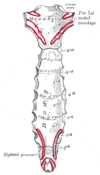





the ribs







the occipital boneOccipital boneThe occipital bone, a saucer-shaped membrane bone situated at the back and lower part of the cranium, is trapezoidal in shape and curved on itself...

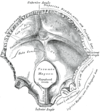
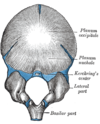
the parietal boneParietal boneThe parietal bones are bones in the human skull which, when joined together, form the sides and roof of the cranium. Each bone is roughly quadrilateral in form, and has two surfaces, four borders, and four angles. It is named from the Latin pariet-, wall....


the frontal boneFrontal boneThe frontal bone is a bone in the human skull that resembles a cockleshell in form, and consists of two portions:* a vertical portion, the squama frontalis, corresponding with the region of the forehead....



the temporal boneTemporal boneThe temporal bones are situated at the sides and base of the skull, and lateral to the temporal lobes of the cerebrum.The temporal bone supports that part of the face known as the temple.-Parts:The temporal bone consists of four parts:* Squama temporalis...
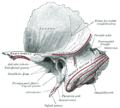






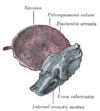
the sphenoid boneSphenoid boneThe sphenoid bone is an unpaired bone situated at the base of the skull in front of the temporal bone and basilar part of the occipital bone.The sphenoid bone is one of the seven bones that articulate to form the orbit...




ethmoid boneEthmoid boneThe ethmoid bone is a bone in the skull that separates the nasal cavity from the brain. As such, it is located at the roof of the nose, between the two orbits. The cubical bone is lightweight due to a spongy construction. The ethmoid bone is one of the bones that makes up the orbit of the eye...
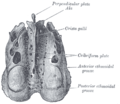



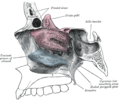
the nasal bones

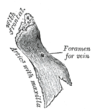

the maxillæ (upper jaw)



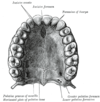

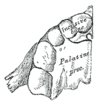
the zygomatic boneZygomatic boneThe zygomatic bone is a paired bone of the human skull. It articulates with the maxilla, the temporal bone, the sphenoid bone and the frontal bone. The zygomatic is homologous to the jugal bone of other tetrapods...
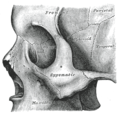



the palatine bonePalatine boneThe palatine bone is a bone in many species of the animal kingdom, commonly termed the palatum .-Human anatomy:...

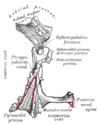
the inferior nasal concha



the vomerVomerThe vomer is one of the unpaired facial bones of the skull. It is located in the midsagittal line, and articulates with the sphenoid, the ethmoid, the left and right palatine bones, and the left and right maxillary bones.-Biology:...



the mandible (lower jaw)
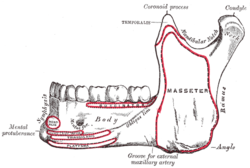
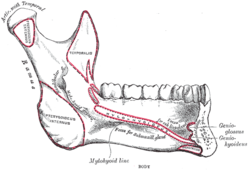








the exterior of the skull


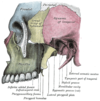
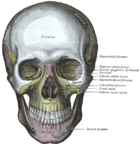


the interior of the skull

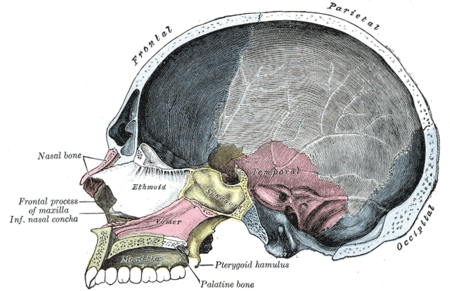


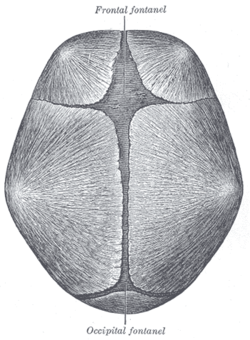


the clavicleClavicleIn human anatomy, the clavicle or collar bone is a long bone of short length that serves as a strut between the scapula and the sternum. It is the only long bone in body that lies horizontally...


the scapulaScapulaIn anatomy, the scapula , omo, or shoulder blade, is the bone that connects the humerus with the clavicle ....
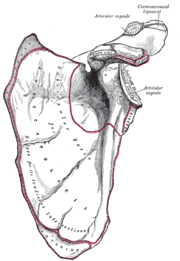
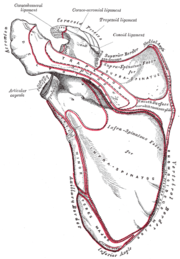


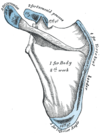
the humerusHumerusThe humerus is a long bone in the arm or forelimb that runs from the shoulder to the elbow....


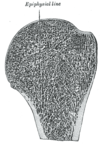
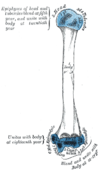
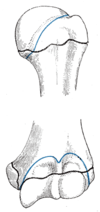
the ulnaUlnaThe ulna is one of the two long bones in the forearm, the other being the radius. It is prismatic in form and runs parallel to the radius, which is shorter and smaller. In anatomical position The ulna is one of the two long bones in the forearm, the other being the radius. It is prismatic in form...

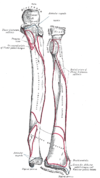
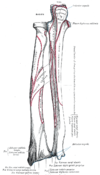
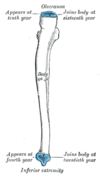
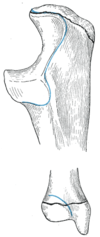
the carpusCarpusIn tetrapods, the carpus is the sole cluster of bones in the wrist between the radius and ulna and the metacarpus. The bones of the carpus do not belong to individual fingers , whereas those of the metacarpus do. The corresponding part of the foot is the tarsus...
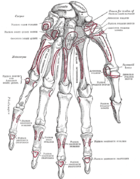









the metacarpus





the hip boneHip boneThe hip bone, innominate bone or coxal bone is a large, flattened, irregularly shaped bone, constricted in the center and expanded above and below...



the pelvis
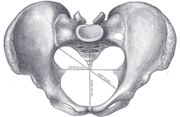
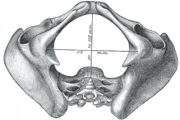



the femurFemurThe femur , or thigh bone, is the most proximal bone of the leg in tetrapod vertebrates capable of walking or jumping, such as most land mammals, birds, many reptiles such as lizards, and amphibians such as frogs. In vertebrates with four legs such as dogs and horses, the femur is found only in...
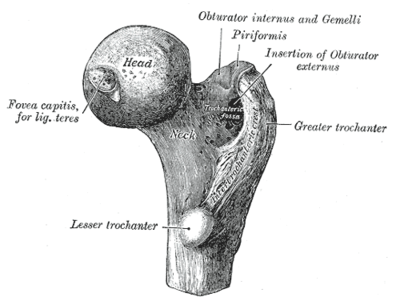



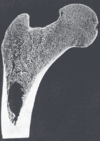
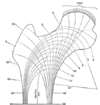

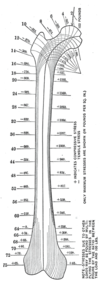

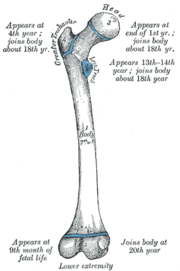
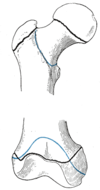

the tibiaTibiaThe tibia , shinbone, or shankbone is the larger and stronger of the two bones in the leg below the knee in vertebrates , and connects the knee with the ankle bones....
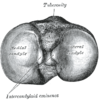



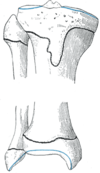
the fibula
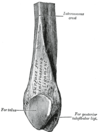

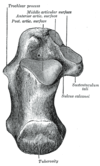
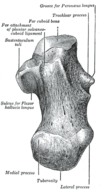
the tarsusTarsus (skeleton)In tetrapods, the tarsus is a cluster of articulating bones in each foot situated between the lower end of tibia and fibula of the lower leg and the metatarsus. In the foot the tarsus articulates with the bones of the metatarsus, which in turn articulate with the bones of the individual toes...





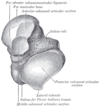











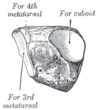
the metatarsusMetatarsusThe metatarsus or metatarsal bones are a group of five long bones in the foot located between the tarsal bones of the hind- and mid-foot and the phalanges of the toes. Lacking individual names, the metatarsal bones are numbered from the medial side : the first, second, third, fourth, and fifth...

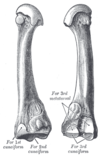


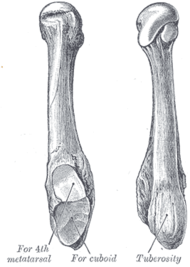
comparison of the bones of the handHandA hand is a prehensile, multi-fingered extremity located at the end of an arm or forelimb of primates such as humans, chimpanzees, monkeys, and lemurs...
and footFootThe foot is an anatomical structure found in many vertebrates. It is the terminal portion of a limb which bears weight and allows locomotion. In many animals with feet, the foot is a separate organ at the terminal part of the leg made up of one or more segments or bones, generally including claws...



